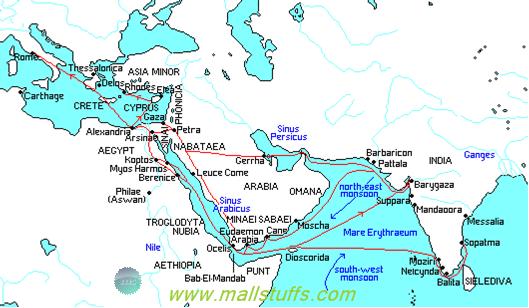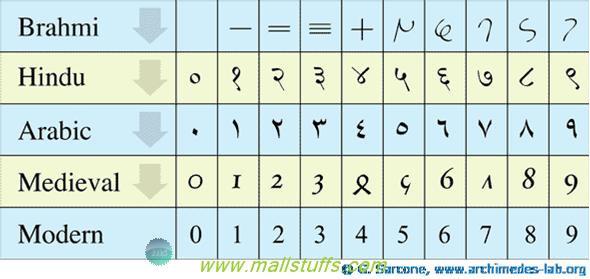
Science in Hinduism-Invention of numeral system
Without numbers there would have been no scientific discovery. Without number system in place, there would have been no computers, no laptops, no ipods, no mobile and no other mechanical devices. Today, everyone knows the importance of numbers system but very few know its origin and history of number system. I guess it is worth knowing how the present number system came into place. So, in this article, we will explore the history, origin, and discovery of number system.
Who invented the number system?
You may find it surprising to know that most of the modern mathematics has been discovered by Indian Vedic sages and mathematicians centuries ago. In fact, Indians made the mathematics simpler through various mathematical concepts. Other civilization later adopted these concepts to enhance their trading system and further discover advanced mathematical formulae and notations out of those concepts. Indians first invented the numbering system, which was later adopted by Arabs to simplify their trading system. Since these numbers system were introduced in Europe by Arabs, Indian numbers systems were mistakenly called as Arabic numerical system (which is now changed to Indo-Arabic or Hindu-Arabic numerical system).
Before seeing how the Indian number system reached Europe let us first see the history of number system
History of number system in ancient civilization
Prior to discovery of Indian number system, other world civilizations like the Egyptians, the Romans, the bablions, and the Chinese used a mechanical device called abacus where symbols on each row of counting beads required its own set of addition or multiplication tables. Mayans on the other hand used lines and dot to represent the number system. Although abacus and mayans way of calculating was suitable for small numbers, calculating large number was so difficult that mathematics virtually came to a standstill in these nations.

Mayans way of representing numbers
So, there was the rising need of some efficient, new form of number system. It was the number system from Indus Valley civilization that solved this problem of calculating large numbers. These discoveries of Indian number system surprised even the greatest western scholars of all times.
Not only the number system, Indian sages pioneered almost all field of mathematics, like arithmetic operation, integral calculus, trigonometry, differential equations, several geometrical and algebraic theorems etc. Even, many notions of physics, astronomy and time distance concepts were calculated by Indian mathematicians.
How Indian number system reached Arab and then europe
Around 770 AD, Famous Indian scholar from Ujjain named Kanka, was invited by king Abaaside Khalif Al-Mansur in his famous court of Baghdad. Kanka taught Vedic mathematics and astronomy to the Arabian scholars. With his help, the famous brahma-sphuta-siddhanta of brahmagupta was translated to Arabia. French savant M.F. Nau in his work proves that the Indian number systems were well known and much appreciated in Syria in 7th century A.D. Through trade, Arab numeral system reached Egypt and from Egypt, they finally entered Europe in 11th Century A.D. Italian mathematician, Leonardo Pisano (aka Fibonacci) completed his education from North Africa, where he learned this number system from arabs and carried it to Italy from where it reached other countries of Europe. Europeans called this number system as Arabic notations, because they learned it from arabs but the Arabs themselves, called their number system as Hindu figures (Al-Arqan-Al-Hindu) and mathematics itself was called as hindisat, meaning “the Indian art"
Indians first discovered the mathematical figure zero (Shunya)
The first documented evidence of ZERO being added as the tenth positional digit is Bakhshali Manuscript , written by brahmagupta sometimes before the 5th century B.C. But the first material evidence of zero as a numerical figure was found in modern Cambodia belonging to the hindu khmer empire, dating back to the seventh century B.C.

Angkor wat, an ancient hindu temple in Cambodia where figures representing zero are found
Philosophical formulations concerning Shunya - i.e. emptiness or void may have lead to the discovery of zero. While zero (bindu) as an empty place holder in the place value number system, its relationship to mathematical functions appeared much earlier in the mathematical rules of Brahmagupta. Although scholars are divided on when the symbol zero came in use as numeric notation of Indian scholars, Indian numerals continuously evolved with various mathematical functions (such as plus, minus, square root etc) eventually laying out the foundation of modern mathematics.
Rules of Brahmagupta
Brahmasputha Siddhanta which means (The Opening of the Universe), written in 628 AD, laid out the algebraic rules concerning zero which are:
� The sum of zero and a negative number is negative.
� The sum of zero and a positive number is positive.
The sum of zero and zero is zero.
The sum of a positive and a negative is their difference; or, if their absolute values are equal, zero.
A positive or negative number when divided by zero is a fraction with the zero as denominator.
Zero divided by a negative or positive number is either zero or is expressed as a fraction with zero as numerator and the finite quantity as denominator.
Zero divided by zero is zero.
Brahmagupta last rule differs from the modern rules of mathematics where modern rules do not have a value to this, whereas calculators and computers assign NaN, for this operation. In some computer science concepts, this operation is considered as positive infinity, negative infinity which in reality is not pure mathematics and are used only for conceptual purpose.
Later, Using zero and one, Indian scholar Pingala laid the foundation of binary numbers which was similar to morse code. He and his associate Indian scholars represented zero or void as śūnya. Indian adopted the methodology of using blank to represent zero on a counting board around 4th century BC. In 498 AD, zero was correctly identified as the digit to be placed before the negative numbers.
How Sunya became Zero
As said earlier, Indian numeral system was carried from india to Europe through Arabs.

Ancient Indo Arab trade Route
Sanskrit word "Shunya" meaning zero is translated in arabic as “sifr", meaning 'nothing'. In medieval Latin it was represented as ‘ciphra’ , then in medieval English as ‘siphre’, in America as cipher and in English as ‘cypher. At the end of the medieval period, modern latin word ‘zephirum’, meaning void came to be used to denote sunya. And that finally entered English as ‘zero’. However, since some countries of medieval Europe considered arabs as heathens, they banned this positional number system, along with zero. So, Sunya(Modern zero) was said to be the creation of the devil. As a result, ‘ciphra’ later got the meaning of a secret code.
However, inspite of opposition by some countries, Indian numeral system were gradually adopted, especially by Italian merchants during the renaissance period, due to its practical advantages over the cumbersome roman numerals. Roman numerals are still in use for certain purposes especially in the Western countries.
Why Indian Zero was adopted by other civilization
Many of the numerals except zero already existed in most ancient civilizations. It was India, who gave zero which became one of the most important tools in mathematics for counting numbers. No other civilization besides India felt the need to invent zero; but as soon as trade was carried on a larger scale, a zero was needed to represent larger numbers. Only three of the four ancient civilizations (the Mayans, the Babylonians, and the Indians) managed to invent something like zero based number system. However, the Mayans and Babylonian representation of zeros were not conceived as numbers, and only the Indian zero had the potential to go forward which is very evident today. It is the Indian zero which became the base of the numbers system used widely today.
As far as order of number system is concerned, we can say very confidently that zero should be used before unit. (i.e zero should come before 1,2,3 and so on). But a point worth thinking is the fact that zero(Which was invented later) is placed before all the numerals invented earlier(1,2,3 etc). In fact, zero changed the whole thinking of number system when it was realized that the void (Zero) is “nothing”, as humans became intelligent to realize their individual solitude in face of life(1) and death(0).

Mandala Of sunya(Void) representing life or death
Evidence of Indian number system
The first recorded evidence of "indian" numerals still in use is Ashoka edicts(Stone columns) from the mauryan period (250 B.C). Similar brahmi inscriptions were later found in caves near Nasik (200 B.C) and Poona (100 B.C).
The evolution of number system from brahmi script to modern number systems can be summarized as:

Indian numerals and modern number system
Below is list of Indian numerals in devnagari script, their transalation to modern number system, Sanskrit pronunciation, and some close pronunciation with western languages.
| Modern Devanagari | Hindu-Arabic or modern number system | Sanskrit word for the ordinal numeral (wordstem) | Translations in some languages | |
|
० | 0 | �hûnya (शून्य) | sifr (Arabic) | |
|
१ | 1 | eka (एक) | echad (Hebrew) |
|
२ | 2 | dvi (द्वि) | dva (Russian) | |
|
३ | 3 | tri (त्रि | )tre (Italian) |
|
४ | 4 | chat�r (चतुर्) | kat�r (albanian) | |
|
५ | 5 | panch (पञ्च) | penki (Lithunian) | |
|
६ | 6 | ṣáṣh (षष्) | seis (Spanish) | |
|
७ | 7 | sapt á (सप्त) | şapte (Romanian) | |
|
८ | 8 | aṣhṭá (अष्ट) | asto�i (Latvian) | |
|
९ | 9 | náva (नव) | nove (Italian) | |
Since Sanskrit is said to be the mother of all languages, it is obvious that the words resembles closely to other ancient languages (Greek and latin).
This number system in mathematics was not the real invention of Indians. The real invention was number zero, decimal or positional based number system, very large numbers up to infinity and various advanced mathematical concepts. Since the details on decimal & place value based number system and advanced mathematics is very huge, I will take it up in my next article. In my next article, we would also see the concept of mathematics in Vedas.
Before I end, a quote from one of the famous mathematician Pierre-Simon Laplace
“The ingenious method of expressing every possible number using a set of ten symbols (each symbol having a place value and an absolute value) emerged from India. The idea seems so simple nowadays that its significance and profound importance is no longer appreciated. Its simplicity lies in the way it facilitated calculation and places arithmetic foremost amongst useful inventions. The importance of this invention is more readily appreciated when one considers that it was beyond the two greatest men of Antiquity, Archimedes and Apollonius”,
Note: Images used on this website
are either a production of Bhaktivedanta Book Trust(https://www.krishna.com), Iskcon
Foundation or were found in google search under "Free to use and share". If any
of the images presented here violates copyright issues or infringes anyone copyright
or are not under "Fair use", then please bring it to our notice. Read
Disclaimer for more.
Share this to your friends. One of your friend is
waiting for your share.
Related Articles
Science in Hinduism-Invention of numeral system
Science in Hinduism-Pythagoras or Baudhayana theorem
Rama Sethu-Proof of India great ancient science
Why Lord krishna had more than 16000 wives
Meaning of word Bihar and why bihari is proud of their culture and origin
Science in Hinduism-Big bang,Creation & destruction of universe
Fall and Rise of river saraswati-India most sacred river
ekdanta vakratundaya english poetic translation with hindi subtitles
Origin of word Hindu
Vedas Quotes Against Present Caste System
Post Comment